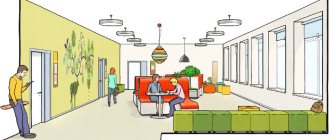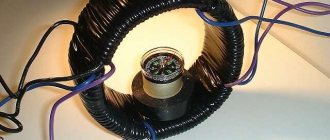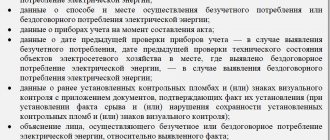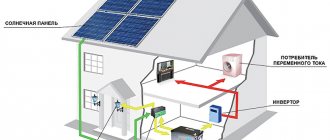Since the beginning of 2021, an updated system for calculating general household needs - ODN - has come into force in Russia. However, not everyone still understands what the established standard for ODN is and how to calculate the amount required to pay for these utilities on a monthly basis. We suggest you look into this.
Before we begin to consider the essence of the changes, let us remember why they were needed. The main goal of the reformers was to realistically calculate utility resources and, based on this, establish a balance between consumption and user payments for it. According to the law “On Amendments to the Housing Code of the Russian Federation and Certain Legislative Acts of the Russian Federation,” adopted in the summer of 2015, from 01/01/2017, the payment for the provision of common property should automatically include services that are relevant when using common property in an apartment building. The amount to be paid is determined by the standard established for each individual republic, and even the territory and region.
The developer of the housing and communal services bill of the Russian Federation planned, by transferring public utilities into housing services, to more strictly charge payments only for resources that actually go to meeting general household needs.
Preparations for changes in the ODN calculation system were carried out throughout almost the entire 2021. In particular, utility companies were instructed to check the compliance of each residential building with energy efficiency requirements to eliminate the possibility of resource leakage - both accidental and intentional.
Dear readers!
Our articles talk about typical ways to resolve legal issues, but each case is unique. If you want to find out how to solve your specific problem, please contact the online consultant form on the right →
It's fast and free!
Or call us by phone (24/7):
Accrual of ODN in 2021
ODN services in 2021 are already included in your receipt. That is, they are not entered as a separate line, but are added to the total amount. Therefore, it’s time to remember that common areas include:
The receipt will include data calculated using common house metering devices (CDMU). They are installed for cold and hot water, as well as electricity and heating.
The house's needs for metering power supply are calculated simply - they represent the difference between the readings of the metering power supply and the sum of the readings of the personal meters of all residents. If the owner of the living space does not have an individual meter, the share of his ODN is distributed proportionally based on the area of the apartment.
What is ODN in an apartment receipt?
ODN stands for general house needs, which must be paid for by residents of multi-storey buildings. The management company provides the invoice for ODN. According to the new rules, the bill size is calculated not according to meter readings, but according to service consumption standards. This change led to the fact that payments for single income tax increased.
According to the new rules adopted in 2021, management organizations have the right to issue payments for ODN, taking into account utility consumption standards, and not the indicators of accounting priors.
It would be ideal if every resident bothered to install an individual electricity meter in their home. So far, the situation is such that even meters are not installed in all houses. The payment for ODN includes a certain number of services, which may change every year.
What is included in the ODN:
- Water. The readings of the common house meter are multiplied by the tariff. The result is an amount payable that residents must cover. The amount is calculated as follows: payments that citizens made according to the standard or according to meter readings are subtracted from the general indicators. The remaining amount is divided among all residents.
- Electricity. Part of all electricity is spent on lighting stairs and entrances, as well as for the proper operation of the elevator. The meter readings are multiplied by the current tariff, as well as by the ODN standard.
To avoid overpaying, every tenant should check their receipts. It often happens that management companies resort to tricks and tricks, forcing citizens to pay significantly larger amounts. At the same time, judicial practice shows that it is difficult to prove such violations, so often the Supreme Court decision is not made in favor of consumers.
What changed
The essence of changes from communal structures in this case lies on the surface. The main thing is that now management companies and homeowners associations cannot, at the expense of apartment owners, cover expenses in excess of state standards for single living expenses, as happened before. Consequently, the issue of eliminating the misuse of resources in houses is acute, because now the HOA and the management company themselves will have to pay for it. Of course, they won’t like it, and therefore there are exactly two options for the development of events.
The easiest way to achieve this is by automating accounting systems. They automatically transmit meter readings from each apartment. The housing and communal services oblige the management companies to install them directly, because, ultimately, it is beneficial to them. But so far the automation procedure is moving very slowly due to the high cost.
What to do about it
Now you know how one rate is calculated for electricity, cold water and heat. It is worth clearly realizing that the adopted reform is not a simple bill, but a decision that has already entered into force. Therefore, we need to adapt to changes now and benefit from them.
In fact, by reforming the payment system for public utility services, we can minimize non-targeted costs that previously arose when paying utility bills. It is clear that it takes years to fight the established mentality, but still, the transition to honesty in paying for utility services is the primary task of each of us.
And this applies not only to residents, but also to representatives of management companies. Of course, not everyone will be willing or able to follow the second path of development, choosing honesty over fraud. Our task, as consumers, is to understand the essence of what is happening and stop attempts at deception on the part of the management company. This is not so difficult to do - just carefully study the formulas for calculating payment for ODN and monthly calculate how much you have to pay to the management company. The formulas we proposed above will absolutely help with this.
Today, everyone can and should install an individual meter at home, promptly reporting its data to the management company. General automation of the transfer of meter readings remains a matter of tomorrow, but its implementation needs to be stimulated today.
The new system for calculating ODN is a reform, in the future aimed at improving the quality of service for each home and optimizing resource consumption. This opportunity is worth taking advantage of, because ultimately, by acting in this way, every owner of a home in an apartment building will be able to improve their own quality of life.
Dear readers!
It's fast and free!
Or call us by phone (24/7).
Comfortable living in an apartment building requires heating and lighting not only in the apartments themselves, but also in common areas, front doors and numerous technical rooms. Today, management companies use the practice of allocating the costs of maintaining such areas to general house needs (GDN). They are paid by apartment owners, and the corresponding payment amounts are indicated in receipts for utility bills. In 2015, federal officials announced changes in the payment of ODN and proposed to classify them as expenses falling under the category of payments for the maintenance of residential premises. When will the transfer of the payment for one-day rent to the housing service take place? How will this affect the payment amount? What will the ODN fee be in 2021? And what can help residents of apartment buildings save on one-room apartments?
Transfer of payment for single living expenses to housing service (HS)
Initially, legislators planned to endow ODN with the concept of “housing maintenance” instead of “utility services” (CS) in the spring of 2016. For a number of reasons, mainly technical, it was decided to postpone the innovation. It turned out that not all management companies were prepared for these changes: they did not equip their facilities with general building meters that take the necessary readings, they did not complete the planned work to increase the energy efficiency of buildings, etc.
Federal Law No. 73 of March 30, 2016 put an end to the issue of the final transfer of the payment for ODN to the category of housing services (HS): it obligated amendments to Article 12 of the Federal Law “On Amendments to the Housing Code of the Russian Federation and certain legislative acts of the Russian Federation "and give them legal force from January 1, 2021. Thus, already in 2017, you will have to pay for electricity, heating, water, as well as cleaning, maintenance and repair of front and technical premises according to the new regulations. At the same time, a new procedure is being established for the distribution of ODN between apartment owners separately for each utility service (CS). It is introduced by the Decree of the Government of the Russian Federation No. 354 “On the provision of utility services to owners and users of premises in apartment buildings and residential buildings.”
Do they take the presidential decree into account or not?
According to Federal Law 258 dated July 29, 2021, as well as Federal Law 176 dated June 29, 2015, signed by the President of the Russian Federation in the Housing Code of the Russian Federation and in the Decree of the Government of the Russian Federation No. 354 “On the provision of utility services...” although payment for DST is assigned to the owners of residential premises, but “ the volume of utility services provided for general house needs during the billing period cannot exceed the volume of utility services calculated based on the consumption standards of the corresponding utility resource” (clause 44 of Section VI of Resolution No. 354).
Single payer fee in 2021
It is expected that this innovation will bring order to the payment of utility services provided for general household needs. First of all, apartment owners will no longer receive receipts with often incomprehensible amounts, which were calculated by specialists of management companies based on outdated standards. House-wide meters (resource consumption metering devices), which are planned to be installed in every Russian apartment building, will show the actual consumption of electricity, water consumption, etc., which will also make it possible to evaluate the energy efficiency of the residential building itself.
In addition, the changes that have already been made to the Housing Code of the Russian Federation obligated at the level of each region to carry out work to calculate standards for the consumption of resources necessary for the maintenance of premises. From now on, both management companies and citizens themselves will receive exact figures that will show how much utilities (CS) for general household needs should cost. The new standards will become a kind of framework, exceeding which will mean ineffective work of the management company. In this case, the latter will no longer be able to exercise initiative in calculating the amounts payable by the residents of the house.
Ways to reduce costs for one-day visits
- Monitor and repair leaks. If you find any breakdowns in the sewer and water pipes in the basement, immediately call the housing department specialists. By eliminating the cause of water consumption, you can also eliminate premature wear and tear of your home due to high humidity.
- Periodically order a check of the common house metering device. If the equipment is in good condition, it will show more accurate indicators. Accordingly, the accounts will reflect the most objective information possible.
- Detect and eliminate unauthorized connections to networks. Most often, unauthorized connections are made to the power supply system. Both the residents of the house and third-party users through the basements can connect to the common lines. If you find such connections, invite representatives of the management company and draw up reports.
- Organize a general meeting of residents and select responsible persons whose responsibilities will include collecting and submitting metering information for a certain period of time.
- Explain to the residents of the house about the need for timely plumbing repairs and saving resources. You can post advertisements in publicly accessible places.
All these measures will allow you to reduce up to 20% of the cost of paying for one-time service.
Calculation of ODN in 2021
In order to calculate the standards for energy consumption used for general household needs, specialists will have to install common building meters (metering devices) in apartment buildings. They will show how much resources were received and how much was spent directly by the residents (according to the readings of individual meters for electricity, water, etc.). The resulting difference will be classified as the communal resource that the house needs.
Having collected evidence from tens and hundreds of thousands of objects, taking into account the types of houses and their equipment with meters and energy-saving equipment (for example, LED lighting in front doors), legislators will receive average standards, which will form the basis for future assessment of the performance of management companies. Why is it necessary to evaluate something? The fact is that from January 2021, at those facilities where the ODN fee will exceed the established standards, or readings cannot be issued due to the lack of meters, residents will have the right to pay for utilities within the limits of the standards, while all expenses exceeding them , will fall on the shoulders of the Criminal Code. Moreover, such a situation may become a reason to refuse the services of the management company (as an exception, it is allowed to pay for housing and communal services in excess of the established standards upon signing the appropriate written consent by all residents of the apartment building).
Thus, the calculation of ODN will make it possible to streamline the work on establishing new standards and will encourage management companies and homeowners associations to pursue a resource-saving policy, including forcing them to install communal water and electricity meters. This, in turn, will affect the overall saving of utility resources, both on the scale of one house and on the scale of an entire region and even a country.
At the same time, those management companies that fail to organize proper work to collect data on the consumption (expense) of resources used for general household needs, from January 2021 will be forced to indicate in receipts the amounts calculated on the basis of the standards established in the region. And since utility service providers will be guided by the readings of their meters, showing what volumes of resources are supplied to the facility, payment of the difference will again be made from the pocket of the management company.
ODN standard for water in 2021
How the ODN payment for water will be calculated can be found in the example that demonstrates the work of Stavropol officials. Thus, representatives of the Ministry of Housing and Communal Services of the Stavropol Territory were among the first to calculate and officially approve standards for the consumption of ODN. Their indicators vary depending on the category of residential buildings and in relation to the water supply of objects are 0.029-0.067 cubic meters of cold water per square meter of living space. In this case, several factors are taken into account:
- the presence of a drainage system in the house,
- the presence of a centralized water supply system,
- types of installed baths (by volume), etc.
In addition, experts included in the standard the volumes of water that will be needed for cleaning the front doors and scheduled (twice a year) flushing of the heating system. All this, according to experts, will allow residents of apartment buildings to pay for water used for general house needs, exactly as much as is necessary directly for servicing the house.
Payment for one day
Since the costs of ODN are shared among residents, it is important to understand how they are calculated. A special formula is used for this: Pi = Viodn NS.
In it:
- Viodn – the share of ODNE per apartment.
- N is a standard approved by the local administration and expressed in kilowatt hours per square meter of area.
- S – apartment area.
Apartment owners often noticed an increase in these payments, which was difficult to justify with real changes in electricity consumption. This was due to violations by management companies.
ODN standard for electricity in 2021
Continuing with the example of the Stavropol Territory, we can see how the standards for electrical energy consumption were calculated. Starting from 2021, the payment for single electricity supply in the Stavropol Territory will range from 2.84 to 11.17 kilowatt-hours per square meter per month. When establishing these standards, experts took into account the categories of residential apartment buildings, the average area of technical and residential premises, the number of storeys of the building, the presence of elevators, intercoms, television antenna amplifiers, etc. Note that in a number of cases, the volumes of electricity that were used for lighting the adjacent building were also taken into account. territories.
What are the standards?
According to the above, the calculation of the payment for one-room service is carried out in accordance with the standards in proportion to the area of the owners' residential premises.
Otherwise, a meeting of the owners of residential premises in the apartment building, held in the prescribed manner, is required, during which a decision is made on the payment for the ODPU in fact (based on the testimony of the ODPU), but, as a rule, the difference between the standard and the fact according to the ODPU is not obtained in benefit of homeowners.
The standards for ODN when calculating the amount of the fee are determined at the regional level in accordance with the resolutions of the “Regional Energy Commissions”.
For example: in the Kemerovo region the standards for ODN are as follows:
- Cold water 0.0055 - 0.0398 m3/month per square meter of total area.
- Hot water 0.0079 – 0.0273 m3/month per square meter of total area.
- Water disposal 0.0026 – 0.0546 m3/month per square meter of total area.
On the nuances of calculating ODN standards in different regions of the country
Utilities used for general household needs cost consumers differently in different regions. In some places, climate or the length of daylight plays a role; in other cases, you have to deal with special types of buildings that differ greatly in their thermal characteristics. Hence, the maintenance of general or technical premises may require different amounts of utility resources.
The standards by which utilities for general household needs will be paid will be influenced by many factors. For example, here are the recently established standards for the consumption of utilities for cold and hot water supply for general house needs in the Belgorod region:
In most regions of the country, standards continue to be calculated, so accurate data for all subjects of the Russian Federation can be expected in 2021.
What does ODN include?
Article 36 of the Housing Code of the Russian Federation specifically outlines what is included in general house needs in an apartment building.
Public areas are:
- basements;
- staircase corridors and landings between apartments;
- technical floors;
- elevator shafts and elevators;
- flights of stairs;
- attics, if they are provided with utilities;
- dryers;
- the plot of land on which the house is built;
- landscaping elements - children's playground, flower beds.
Example
Wet cleaning of entrances is carried out daily; water is used for this, for example, 5 m³ of water . Flowerbeds have been planted on the territory of the apartment building, which also require 5 m³ of water for watering. These services are considered general house services, and the costs associated with them are included in the monthly payment receipt.
Every month, the management company or HOA takes readings from a common meter that records the consumption of water, electricity or heat. The information is verified with the readings of the residents’ individual meters.
How to save money on utility bills?
Apartment owners can regard the innovations, which will come into force on January 1, 2021, as the first step towards optimizing their costs for paying for housing and communal services. Each apartment owner, who has standards for the consumption of resources necessary for the maintenance of premises (residential and common), will be able to evaluate the performance of their management company and initiate work to improve the energy efficiency of their housing. Here it will also be possible to assess the volume of consumption of utility resources directly in the apartment: metering devices will provide accurate data that will help to understand where consumption is excessive, or why heating one apartment is more expensive than the neighboring one.
Finally, homeowners in apartment buildings will see how much it costs them to maintain common front or adjacent areas. Perhaps, based on the evidence received, many will be able to find ways to resolve pressing issues related to saving utility resources and reducing the amount of payment for general household needs for electricity, water, etc.
General house needs (CHN) - consumption of heat and electricity in the entrances, basement, and attic of an apartment building. In order to encourage apartment owners to save energy resources, the Russian authorities have established a fee for electricity spent on outdoor heating equipment in multi-storey buildings. Service companies have the right to charge these payments since May 2006.
Initially, for general house needs in multi-storey buildings, it was carried out strictly according to standards. This payment was an insignificant part of the fee for the use of the owners' resources. With the adoption of Russian Government Resolution No. 344 in April 2013, its accrual depends on the area of living space.
To understand how ODN for electricity is calculated, it is necessary to consider the formulas approved by the government and mandatory for use.
Calculation of ODN consumption for electricity
For convenience, we introduce one coefficient - this is the share of a specific apartment in the area of all rooms in the house:
Kpl=Pkv/Pozh
where: Pkv – apartment area; Well - common, residential building.
Let all rooms in the house be 1830 square meters. m, and the area of one apartment is 45 sq. m – coefficient is 0.025.
In the absence of a common house meter
In each house, the owners have a choice - to enter into an agreement for the payment of electricity at the ODN with an energy sales company or to entrust settlements with them to their house management (MC). The government decree stipulates that management companies must charge fees for ODN no higher than the standards established in the region. Therefore, they calculate the electricity consumption of the management company in the same way as in houses, without meters:
Rel=Nel*Pnzh*Kpl
,
where: Rel – consumed electricity; Nel – standard one per 1 sq. m; Pnzh – area of non-residential premises.
In the same house with a total area of 1830 sq.m, non-residential premises - 380 sq.m, then Rel, with a standard of 1.26 kW, will be:
Rel=1.26*380*0.025, that is, 11.97 kW.











